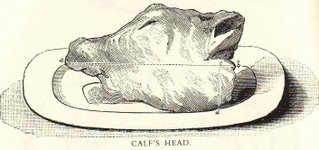 Today, November 17th …
Today, November 17th …Jane Austen kept up a regular correspondence with her beloved sister Cassandra, and the letters are as full of the witty, pithy observations on life as are her novels. On this day in 1798 she wrote:
“I am very fond of experimental housekeeping, such as having an ox-cheek now and then, I shall have one next week, and I mean to have some little dumplings put into it, that I may fancy myself at Godmersham.”
Godmersham was the home of Jane’s brother Edward, and she visited there often. But what did she mean by “experimental housekeeping”? Her comment sounds very tongue-in-cheek, as if there is some insider family joke going on. Jane was certainly not indicating that the cooking of ox-cheek itself constituted experimental housekeeping. It was part of the standard repertoire of any ordinary cook, as cookbooks of the time show. John Nott’s ‘Cook’s and Confectioner’s Dictionary’ (1724) for example gave five ways of preparing it – baked, boiled (2 versions), marinated, and in pie.
Ox-cheek pie could be very luxurious, with the meat being cooked slowly overnight, then removed from the bone and layered with truffles, artichokes, asparagus, forcemeat balls, and hard eggs, topped up with good gravy then covered with puff pastry ornamented with pastry leaves. Essentially though, ox-cheek was a cheap cut of meat, and much more likely to be made into soup. One of the chief desirable virtues in a housewife or housekeeper has always been thrift, and ox-cheek provided an excellent opportunity to demonstrate thriftiness. The basic soup could also provide a second course, as “the meat, when taken from the bones, may be served as stew”. For the less squeamish, it could even be poured over the unsliced head, as in the following recipe (which also uses the ox palates) from the same year as Jane’s letter:
Ox-cheek Soup.
Take half an ox-head, and cut the cheek clean from the bones, break the bones to pieces, and put them in a large pan of water all night to soak out the blood; in the morning wash them clean out, and put them into a pot with six quarts of water, when the scum rises, skim it well; take six onions, six heads of cellery, about four leeks, and two turneps, well washed and cut in two, with a bundle of sweet herbs, a spoonful of all-spice, some cloves and mace, and a little salt; put in two palates, and stew them till tender, then take them out and throw them into cold water, and take off the skins; cut them into square pieces, stew the head five hours, try if the head is tender, if not stew it gently till it is; then take it out, and strain the soup into a pan to settle, skim it well, and pour it from the settlings; put a quarter of a pound of butter in a stew-pan and melt it, put two large spoonfuls of flour in, and stir it about till it is smooth; by degrees put the soup in, keep stirring for fear it should go into lumps, if it does you must strain through a sieve, put in half a pint of white wine, and season it with Cayan pepper and common pepper and salt, nearly as hot as mock turtle; in the meantime cut a carrot and two turneps in dice, four heads of cellery and two leeks about half an inch long, boiled in water till tender, strain them in a sieve, and put them to the soup; cut the cheek in square pieces and put it in with the palates, and two spoonfuls of browning, stew it gently for half an hour and skim the fat off clean; put it in a soup-dish or tureen with crispt bread in a plate.N.B. You may put the cheek whole in a large soup dish, if you like it best, and the soup over it.
[Briggs, Richard. The English art of cookery, according to the present practice; being a complete guide to all housekeepers, on a plan entirely new; ... 1798]
Another desirable virtue of housewives and housekeepers was charity, and one of its manifestations was the provision of soup for the poor. A good woman called Hannah More produced a little 16 page booklet round about the time of Jane’s letter, to help with this activity. It was called ‘The cottage cook, or, Mrs. Jones’s cheap dishes; shewing the way to do much good with little money.’ The soup recipe she recommended was so thrifty it used only one ox-cheek and was so charitable that it fed sixty poor souls at her recommended rate of a pint per grown up. The recipe was:
An ox cheek, two pecks of potatoes, a quarter of a peck of onions, one ounce of pepper, half a pound of salt, boiled together in ninety pints of water till reduced to sixty, any garden stuff may be thrown in.
A very versatile meat, ox-cheek. What happens to it nowadays?
A Previous Story for this Day ….
The story for November 17th 2005 was “The Clerical Gourmet”
Monday’s Story …
Queen’s Cake and Bride’s Pie.
Quotation for the Day …
The soup, thin and dark and utterly savorless, tasted as if it had been drained out of the umbrella stand. Margaret Halsey (1910-1997)
I absolutely love this recipe! Unfortunately these sorts of things are misssed out of our lives nowadays. BRING THEM BACK!! i'd love to see more of these things on british tables at tea time with the family..
ReplyDeleteHello Confusinglee - Yes, people dont seem to like these cuts anymore - we are too squeamish. Also I think they take too long to prepare, and no-one wants to do that anymore.
ReplyDelete